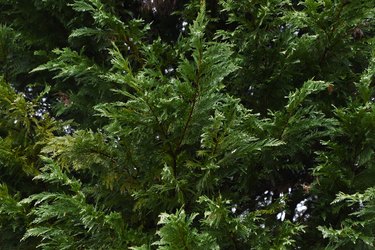
Popular for their fast growth and good looks, Leyland cypress trees (Cupressus × leylandii, USDA zones 6 to 10) are commonly used for their dense hedging ability. To keep these green beauties looking and performing their best, proper watering practices are important. If it is not grown in its preferred conditions and watered correctly, the tree is prone to developing root rot.
Description and Notable Characteristics
Video of the Day
A hybrid cross between nootka false cypress (Chamaecyparis nootkatensis, USDA zones 4 to 7) and Monterey cypress (Cupressus macrocarpa, USDA zones 7 to 10), both native to the United States, the Leyland cypress was first discovered in Wales in 1888. The conifer inherited its rapid growth from the Monterey cypress and its cold tolerance, growth habit and foliage from nootka false cypress.
Video of the Day
Growing 3 feet yearly, the Leyland cypress tree typically grows 60 to 70 feet tall but can soar to a height of 100 feet with a spread of around 15 feet. It has a dense, columnar shape filled with slender branches holding sprays of greenish-gray foliage that eventually hold 3/4-inch brown cones. The scaly bark is brownish-red.
Due to the Leyland cypress's nonallergenic nature, it's commonly used as a Christmas tree for allergy sufferers. Its dense habit of growth and extremely fast growth make it useful for adding privacy as a hedge, screen or windbreak.
Growing and Watering a Leyland Cypress
The best thing you can do to keep your Leyland cypress tree performing at its best is to plant it in a preferred location with preferred conditions and water it properly. They grow into extremely large trees, so consider their mature size when selecting a permanent location. You don't want to plant them too close to a structure or fence or under power lines, and if planting multiples for a hedge, allow enough room for trees to mature without crowding, which promotes disease. The conifer grows best in full sun, as too much shade causes loss of vigor; branches thin, and it's more prone to disease. Although it tolerates a variety of soils that drain well, fertile, well-drained soils promote the best growth.
Water newly planted trees several times weekly for the first month while the root system begins establishment. Depending on local weather conditions, irrigate established trees every week to two weeks. Although moderately tolerant to drought once established, regular moisture produces good growth and wards off disease. Covering the planting site with several inches of organic mulch reduces unwanted weed growth and assists the soil in retaining moisture. Just keep it several inches away from the tree's base to prevent rot.
You can easily test the soil's moisture content with a shovel. Dig down about 4 inches near the tree's base, creating a gap. Feel the soil and if it's damp, you don't need to water, but if it feels dry, then give the Leyland cypress a good drink of water.
Problems Associated With Poor Watering
Properly watering your Leyland cypress is one of the most important aspects of its care. The most common root rot affecting the tree is Phytophthora root rot, which occurs due to improper watering or soil that doesn't drain well and stays too wet. Severely affected trees develop darkened roots, stunted growth, a loss of vigor and yellowed foliage. Additionally, needles and branches become smaller, tips die back and the disease could kill the tree.
However, the root rot is most damaging to smaller, immature Leyland cypress, as older and more mature trees seem to be able to weather the problem. You can prevent root rot by growing the tree in its preferred conditions, not planting it too deeply, making sure the soil drains well and adding a layer of mulch as well as watering when needed, especially during hot and dry weather.